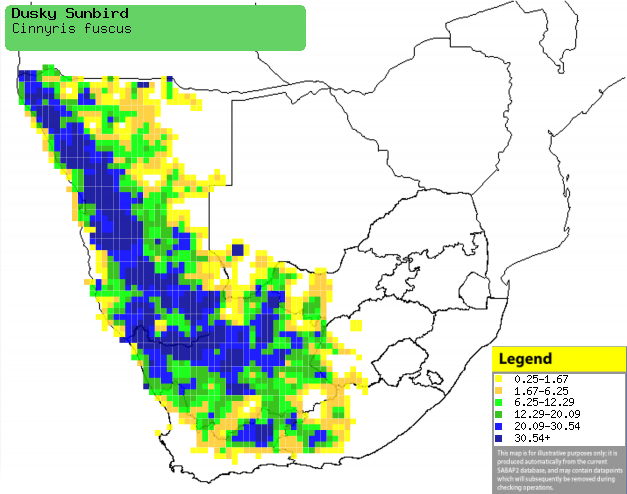|
Cinnyris fuscus (Dusky sunbird)
[= Nectarinia fusca]
Namakwasuikerbekkie [Afrikaans]; Roethoningzuiger [Dutch];
Souimanga fuligineux [French]; Rußnektarvogel [German]; Beija-flor-sombrio
[Portuguese]
Life
> Eukaryotes >
Opisthokonta
> Metazoa (animals) >
Bilateria >
Deuterostomia > Chordata >
Craniata > Vertebrata (vertebrates) > Gnathostomata (jawed
vertebrates) > Teleostomi (teleost fish) > Osteichthyes (bony fish) > Class:
Sarcopterygii (lobe-finned
fish) > Stegocephalia (terrestrial
vertebrates) > Tetrapoda
(four-legged vertebrates) > Reptiliomorpha > Amniota >
Reptilia (reptiles) >
Romeriida > Diapsida > Archosauromorpha > Archosauria >
Dinosauria
(dinosaurs) > Saurischia > Theropoda (bipedal predatory dinosaurs) >
Coelurosauria > Maniraptora > Aves
(birds) >
Order: Passeriformes > Family: Nectariniidae
Distribution and habitat
Near-endemic to southern Africa, occurring from central
Angola to Namibia and the western half of South Africa, marginally extending
into south-western Botswana. It generally prefers drainage line woodland in
succulent and Nama Karoo, semi-arid coastal plains with sand dunes, scrub along
rivers and streams and rocky inselbergs with adequate cover, sometimes moving
into gardens.
|
 |
|
Distribution of Dusky sunbird in southern Africa,
based on statistical smoothing of the records from first SA Bird Atlas
Project (©
Animal Demography unit, University of
Cape Town; smoothing by Birgit Erni and Francesca Little). Colours range
from dark blue (most common) through to yellow (least common).
See here for the latest distribution
from the SABAP2. |
Brood parasites
It has been recorded as host of the
Klaas's cuckoo.
Food
It mainly eats nectar supplemented with arthropods, hawking
insects aerially and gleaning prey from foliage and spider webs. The following food items have been recorded
in its diet:
- Nectar
- Aloe
- A. aspersifolia (Kraal aloe)
- A. dichotoma (Quiver-tree)
- A. littoralis (Mopane aloe)
- A. marlothii (Mountain aloe)
- A. grandidentata (Bontaalwyn)
- A. gariepensis
- A. hereroensis (Sandaalwyn)
- A. zebrina (Zebra aloe)
- Cadaba aphylla (Leafless wormbush)
- Crassula
- Crocosmia (falling stars)
- Drosanthemum (mesembryanthemums)
- Hibiscus
- Leonotis (wild dagga)
- Lycium (honey-thorns)
- Psilocaulon (asbos)
- Loranthaceae (mistletoes)
- alien plants
- Lantana camara (Cherry-pie)
- Nicotiana glauca (Wild tobacco)
- Canna
- Insects and other invertebrates
Breeding
- The nest is built solely by the female in about a week, consisting of an
oval-shaped structure with a side top entrance made of dry grass, plant
fibres, dry leaves and bark, bound together with spider web. It sometimes
decorates it with wool and paper, lining the interior with soft seed fibres
and animal hair. It typically attaches the back of the nest using spider web
to branches of a shrub or tree, or between the thorns of a prickly-pear
cactus (Opuntia).
- Opportunistic breeder, as it lays its eggs after rainfall, usually in
the period from June-March.
- It lays 2-3 eggs, which are incubated solely by the female for about
12-13 days.
- The chicks are brooded solely by the female but fed by both adults,
leaving the nest after about 13-15 days. As juveniles they continue to roost
in the nest for about 2 weeks longer, becoming fully independent soon
afterwards.
Threats
Not threatened.
References
-
Hockey PAR, Dean WRJ and Ryan PG 2005. Roberts
- Birds of southern Africa, VIIth ed. The Trustees of the John Voelcker
Bird Book Fund, Cape Town.
|
